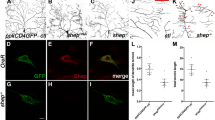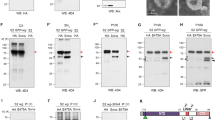Abstract
THE lin-12 and glp-1 genes of Caenorhabditis elegans encode members of the Notch family of transmembrane proteins1,2. Genetic studies indicate that the lin-12 and glp-1 proteins act as receptors in specific developmental cell interactions3–6 and that their functions are partially redundant7, lin-12 glp-1 double mutants display certain embryonic defects not found in either single mutant7,8. The phenotype of this double mutant is called Lag, and recessive mutations in either of the genes lag-1 or lag-2 can also result in the Lag phenotype7, indicating that these two genes may participate in the same cell interactions that require lin-12 or glp-1. We report here that lag-2 encodes a predicted transmembrane protein of 402 amino acids. The predicted extracellular region of lag-2 is similar to amino-terminal regions of Delta and Serrate, two Drosophila proteins that are thought to function as ligands for Notch9–14. The region of similarity includes sequences related to epidermal growth factor (EGF) repeats. We have isolated lag-2(sa37), a dominant allele that shows specific genetic interactions with lin-12. The sa37 mutation causes a Gly->Asp change in a conserved residue of an EGF motif. Because of its overall structure, its sequence similarity to Delta and Serrate, and its genetic interactions, we suggest that lag-2 encodes an intercellular signal for the lin-12 and glp-1 receptors.
Similar content being viewed by others
References
Yochem, J. & Greenwald, I. Cell 58, 553–563 (1989).
Austin, J. & Kimble, J. Cell 58, 565–571 (1989).
Greenwald, I. S., Sternberg, P. W. & Horvitz, H. R. Cell 34, 435–444 (1983).
Priess, J. R., Schnabel, H. & Schnabel, R. Cell 51, 601–611 (1987).
Austin, J. & Kimble, J. Cell 51, 589–599 (1987).
Seydoux, G. & Greenwald, I. Cell 57, 1237–1245 (1989).
Lambie, E. J. & Kimble, J. Development 112, 231–240 (1991).
Bowerman, B., Tax, F. E., Thomas, J. H. & Priess, J. R. Development 116, 1113–1122 (1992).
Vassin, H., Bremer, K. A., Knust, E. & Campos-Ortega, J. A. EMBOJ. 6, 3431–3440 (1987).
Kopczynski, C. C., Alton, A. K., Fechtel, K., Kooh, P. J. & Muskavitch, M. A. T. Genes Dev. 2, 1723–1735 (1988).
Fleming, R. J., Scottgale, T. N., Diederich, R. J. & Artavanis-Tsakonas, S. Genes Dev. 4, 2188–2201 (1990).
Thomas, U., Speicher, S. A. & Knust, E. Development 111, 749–761 (1991).
Fehon, R. G. et al. Cell 61, 523–534 (1990).
Rebay, I. et al. Cell 67, 687–699 (1991).
Appella, E., Weber, I. T. & Blasi, F. FEBS Lett. 231, 1–4 (1988).
Wharton, K. A., Johansen, K. M., Xu, T. & Artavanis-Tsakonas, S. Cell 43, 567–581 (1985).
Rogers, S., Wells, R. & Reichsteiner, M. Science 234, 364–368 (1986).
Greenwald, I. & Seydoux, G. Nature 346, 197–199 (1990).
Heitzler, P. & Simpson, P. Development 117, 1113–1123 (1993).
Seydoux, G., Schedl, T. & Greenwald, I. Cell 51, 939–951 (1990).
Coffman, C., Harris, W. & Kintner, C. Science 249, 1438–1441 (1990).
Heitzler, P. & Simpson, P. Cell 64, 1083–1092 (1991).
Kooh, P. J., Fehon, R. G. & Muskavitch, M. A. T. Development 117, 493–507 (1993).
Johnsen, R. C., & Baillie, D. L. Genetics 129, 735–752 (1991).
Rosenbluth, R. E. & Baillie, D. L. Genetics 99, 415–428 (1981).
Sambrook, J., Fritsch, E. F. & Maniatis, T., Molecular Cloning: A Laboratory Manual 2nd edn (Cold Spring Habor Laboratory Press, New York, 1989).
Mello, C. C., Kramer, J. M., Stinchcomb, D. T. & Ambros, V. EMBOJ. 10, 3959–3970 (1991).
DeLong, L., Casson, L. D. & Meyer, B. J. Genetics 117, 657–670 (1987).
Loh, Y. P., Brownstein, M. J. & Gainer, H. A. Rev. Neurosci. 7, 189–222 (1984).
Sanger, F., Nicklen, S. & Coulson, A. Proc. natn. Acad. Sci. U.S.A. 74, 5463–5467 (1977).
Altschul, S. F. & Lipman, D. J. Proc. natn. Acad. Sci. USA. 87, 5509–5513 (1990).
Author information
Authors and Affiliations
Rights and permissions
About this article
Cite this article
Tax, F., Yeargers, J. & Thomas, J. Sequence of C. elegans lag-2 reveals a cell-signalling domain shared with Delta and Serrate of Drosophila. Nature 368, 150–154 (1994). https://doi.org/10.1038/368150a0
Received:
Accepted:
Issue Date:
DOI: https://doi.org/10.1038/368150a0
- Springer Nature Limited
This article is cited by
-
Higher-order epistasis shapes natural variation in germ stem cell niche activity
Nature Communications (2023)
-
A somatic proteoglycan controls Notch-directed germ cell fate
Nature Communications (2021)
-
Cell‐cycle regulation of NOTCH signaling during C. elegans vulval development
Molecular Systems Biology (2012)
-
The putative Notch ligand HyJagged is a transmembrane protein present in all cell types of adult Hydra and upregulated at the boundary between bud and parent
BMC Cell Biology (2011)





